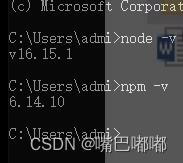快速上手angular8常见使用
Posted 嘴巴嘟嘟
tags:
篇首语:本文由小常识网(cha138.com)小编为大家整理,主要介绍了快速上手angular8常见使用相关的知识,希望对你有一定的参考价值。
前提 什么是 Angular?
官网:https://angular.cn/guide/what-is-angular
Angular 是一个基于 TypeScript 构建的开发平台。它包括:
- 一个基于组件的框架,用于构建可伸缩的 Web 应用
- 一组完美集成的库,涵盖各种功能,包括路由、表单管理、客户端-服务器通信等
- 一套开发工具,可帮助你开发、构建、测试和更新代码
1、搭建Angular开发环境
前提:NG需要Node.js V10.9以上
我的电脑node和npm环境

①下载并安装脚手架工具
npm install -g @angular/cli
②运行脚手架工具创建空白项目
ng new my-app
③进入空白项目并运行开发服务器
cd my-app
ng serve --open

Angular项目启动过程分析:
(1)angular.json:NG项目的配置
index:./src/index.html <app-root></app-root>
main:./src/main.ts 打包入口文件
(2)main.js > bootstrapModule(AppModule) 主模块,引导启动
(3)app.module.ts > bootstrap:[AppComponet]
(4)app.components.ts > selector:'app-root' 选择器
> templateUrl:'app.component.html' 模板
(5)app.component.html > HTML片段... 放到<app-root></app-root>
2、核心概念之一:模块
Module:不同Node.js或ES6中的模块的模块,NG中的模块就是一个抽象的容器,用于对组件的进行分组
整个一个用初始时有且只有一个主模块:AppMoDULE
3、核心概念之二:组件
组件
提示:NG中,任何一个组件都必须声明在一个模块中!
自定义步骤:
体验版
①创建组件class
import Component from "@angular/core";
// 组件 = 模板 + 脚本 + 样式
// 装饰器(Decorator)--用于指定class的用途
@Component(
template: '<h2>myc01</h2>',
selector: 'app-myc01'
)
export class MyC01Component
②在某个模块中注册class
import BrowserModule from '@angular/platform-browser';
import NgModule from '@angular/core';
import AppRoutingModule from './app-routing.module';
import AppComponent from './app.component';
import MyC01Component from './myc01.component';
// 装饰器中的元数据来实现
@NgModule(
// 声明
declarations: [
AppComponent,
MyC01Component
],
// 导入
imports: [
BrowserModule,
AppRoutingModule
],
// 依赖注入提供程序的列表。
providers: [],
// 自动引导的组件列表。
bootstrap: [AppComponent]
)
export class AppModule
③使用组件
app.component.html
<app-myc01></app-myc01>
> angular提供组件化的简化工具
> ng generate component 组件名
> npx ng generate component组件名
简化:generate g
4、Angular核心概念之三:数据绑定
1.数据绑定
- HTML绑定: NG表达式
import Component from '@angular/core';
@Component(
selector: 'app-myc02',
templateUrl: './myc02.component.html',
styleUrls: ['./myc02.component.scss']
)
export class Myc02Component
message = 'Hello word'
html
<p>message</p>
算术运算、比较运算、逻辑运算、三目运算、调用函数
2)属性绑定
形式一:<p title="message">这是一个数据</p>
形式二:<p [title]="message">这也是一个数据</p>
3)指令绑定
(1)HTML绑定
<p>age?18:20</p>
(2) 属性绑定 []
注意:属性绑定通常赋值为变量,如果赋值为常量(如字符串常量)必须用引号括起来,如<img [src]=“‘…/assets/’+imgUrl”>
(3) 双向绑定
4)事件绑定
<button (click)="handleBtn()">点击事件</button>**加粗样式**
handleBtn()
console.log('点击事件')
5)双向数据绑定
<input/select/textarea [(ngModel)]="" />
<input type="text" [(ngModel)]="userName" placeholder="输入数据" />
<p>当前用户输入userName</p>
2.指令系统
1)循环绑定:*ngFor
<ul>
<li *ngFor="let e of emList">
e
</li>
<li *ngFor="let e of emList;let i =index">
e---i
</li>
<li *ngFor="let e of emList; index as i">
e---i
</li>
</ul>
2)选择绑定:*ngIf
<p *ngIf="isPayIngUer">
会员用户可见
</p>
说明:如果布尔表达式为false,则元素从DOM树上删除
<p *ngIf="isPayIngUer;else elseBlock">会员用户可见</p>
<ng-template #elseBlock>普通用户</ng-template>
3)样式绑定:[ngStyle]
说明:ngStyle绑定的值必须是一个对象!对象属性就是CSS样式名
<div [ngStyle]="myStyleObj">样式绑定</div>
myStyleObj =
background: 'red',
color: '#eff'
4)样式绑定:[ngClass]
说明:ngClass绑定的值必须是一个对象!对象属性就是CSS class名,属性值为true/false,true的话class就出现,否则class不出现
<div [ngClass]="myClassObj">样式绑定</div>
myClassObj =
btn: true,
'btn-color': true
5)了解:特殊的选择绑定:
<ANY [ngSwitch]="表达式">
<ANY *ngSwitchCase="值1"></ANY>
...
<ANY *ngSwitchDefault></ANY>
</ANY>
- 双向数据绑定:ngModel——重点
[()]
方向1:Model => View 模型变则视图变 用[]绑定
方向2:View => Model 视图变则模型变 用()绑定
<input/select/textarea [(ngModel)]="" />
<input type="text" [(ngModel)]="userName" placeholder="输入数据" />
<p>当前用户输入userName</p>
注意 ngModel指令不在CommonModule模块中,而在FormsModule中,使用之前必须在主模块中导入该模块
import FormsModule from "@angular/forms";
@NgModule(
// 导入
imports: [
FormsModule
]
)
export class AppModule
结论
指令分为三类
1)组件指令:NG中Components 继承Directive
2)结构型指令 会影响DOM树的结构 必须使用*开头
3)属性型指令 不会影响DOM结构,只是影响元素外观或行为必须使用[]
3.拓展 自定义指令
提示 创建指令的加单工具:ng g directive 指令名
自定义指令都是作为元素的属性来使用,selector应该是:[指令名]
<ANY xuYaoQiangDiao>...</ANY>
myc01.component.ts
import Directive, ElementRef from '@angular/core'
@Directive(
selector: '[appXuYaoQiangDiao]'
)
export class XuYaoQiangDiao
// 构造方法
constructor(el: ElementRef)
console.log(el)
el.nativeElement.style.background = '#fcc'
app.module.ts
import BrowserModule from '@angular/platform-browser';
import NgModule from '@angular/core';
import XuYaoQiangDiao from './xu-yao-qiang-diao.directive';
// 装饰器中的元数据来实现
@NgModule(
// 声明
declarations: [
XuYaoQiangDiao
]
)
export class AppModule
5、Angular核心概念之四:过滤器
Filter:过滤器,用于在View中呈现数据时显示为另有一种格式;过滤器的本质是一个函数,接收原函数转换为新的格式进行输出:
function(oldVal) 处理 newVal
使用过滤器:e.salary | 过滤器
自定义管道的步骤:
1)创建管道class,实现转换功能
创建app文件夹下面的 文件 sex.pipe.ts
import Pipe from "@angular/core";
@Pipe(
name: "sex" // 过滤器/管道名
)
export class SexPipe
// 管道到执行的过滤任务的是一个固定的函数
transform(value, lang = 'zh')
if (lang === 'zh')
if (value === 1)
return '男'
else
return '女'
else if (lang === 'en')
if (value === 1)
return 'man'
else
return 'woman'
2)在模块中注册管道
在app.module.ts 声明
import BrowserModule from '@angular/platform-browser';
import SexPipe from './sex.pipe';
// 装饰器中的元数据来实现
@NgModule(
// 声明
declarations: [
AppComponent,
SexPipe
],
)
export class AppModule
3)在模板视图中使用管道
html
<p>
0 | sex
</p>
<!-- 使用冒号给管道传递参数 -->
<p>
1 | sex:'en'
</p>
创建管道对象的简便工具:ng g pipe 管道名称
Angular 提供了预定义管道

2.创建对象的两种方式
方式1:手工创建 自己创建 let c = new Car()
方式2:依赖注入 无需手工创建new,只需要声明依赖
6、Angular核心概念之五:服务和依赖注入——抽象&重点
Service:服务,Angular认为:组件是与用户交互的一种对象,其中的内容都应该与用户操作有关系的;而与用户操作无关的内容都应该剥离出去,放在“服务对象”中,为组件服务;例如:日志记录、计时统计…
创建服务对象的步骤:
1)创建服务对象并指定服务提供者
log.servive.ts
import Injectable from '@angular/core'
// 所有的服务对象都是“可被注入的” 创建服务单例的
@Injectable(
providedIn: 'root' // 指定当前服务对象在根模块中执行(根模块)
)
// 服务对象
export class LogService
// 执行日志服务
doLog(action)
let uname = ''
let time = new Date().getTime()
console.log(`管理员:$uname时间:$time事件:$action`)
2)在组件中声明依赖,服务提供者就会自动注入进来,组件直接使用服务对象即可
modules.ts
import Component, OnInit from '@angular/core';
import LogService from '../log.service';
@Component(
selector: 'app-ngc04',
templateUrl: './ngc04.component.html',
styleUrls: ['./ngc04.component.scss']
)
export class Ngc04Component implements OnInit
// 服务使用者,必须声明依赖
log = null
// 声明依赖
constructor(logs: LogService)
this.log = logs
doAdd()
this.log.doLog('增添')
doDelete()
this.log.doLog('删除')
ngOnInit()
每个组件对应的服务(都是新建)
组件名
import Component, OnInit from '@angular/core';
import LoginService from '../login.service';
@Component(
selector: 'app-user-login',
templateUrl: './user-login.component.html',
styleUrls: ['./user-login.component.scss'],
providers: [LoginService] //仅给当前组件的服务提供
)
export class UserLoginComponent implements OnInit
timerLog = null
constructor(timerLog: LoginService)
this.timerLog = timerLog
ngOnInit()
doRegister()
this.timerLog.start()
console.log('向服务器提交注册信息')
console.log('服务器返回响应消息:success')
this.timerLog.end('注册')
服务
import Injectable from '@angular/core';
// @Injectable(
// providedIn: 'root'
// )
@Injectable()
export class LoginService
startTime = 0
endTime = 0
constructor()
console.log('创建服务')
start()
this.startTime = new Date().getTime()
end(action)
setTimeout(() =>
this.endTime = new Date().getTime()
console.log(action + '耗时', this.endTime - this.startTime)
, 200)
- 服务对象的作用范围
方式1:根模块中提供服务对象——整个应用中服务是单例
方式2:在组件中提供服务对象——每个组件中服务都是一个实例
注意:项目中只要服务对象中有属性,只能用方式2,否则使用方式1
简化工具:ng g service 服务名
以上是关于快速上手angular8常见使用的主要内容,如果未能解决你的问题,请参考以下文章